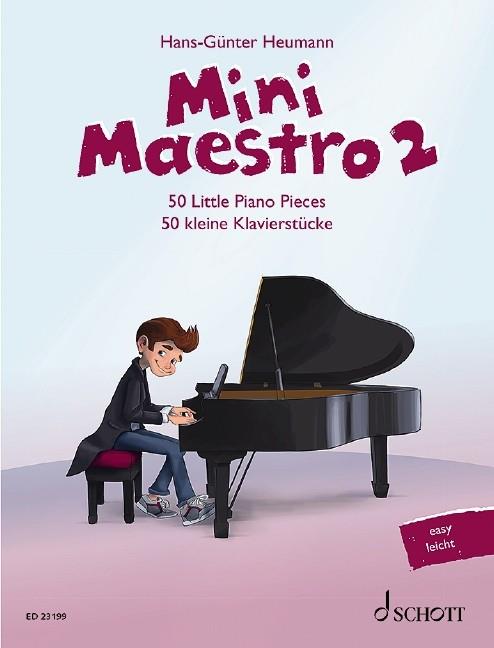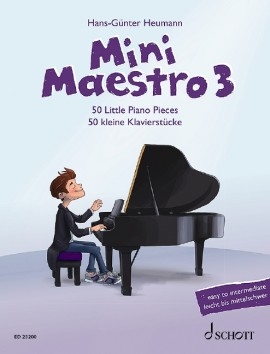
There are a few landmark pieces I tend to use with most of my students at some point in their development. Rachmaninoff's Prelude in C sharp minor Op 3 No 2 is a good one for getting relatively advanced students to move around the keyboard. It has a particularly aspirational quality to it, certainly when given to a student at the right point in their learning. But when it comes to students earlier in their development, I confess I'm often at sea with what to give them, and when.
The Mini Maestro series from Schott is a particularly welcome addition to my library. Three volumes of pieces, arranged in a carefully progressive order from ‘very easy’ to ‘intermediate to easy’, cover a space where students can easily be put off by repertoire that is either too challenging or too easy. As you would expect from Schott, the publications themselves are nicely high quality. Cream-coloured heavy-weight paper that will take a good few pencil marks and rapid page turns, clear typeface, and inviting-but-not-distracting cover designs all combine to let us know we're in safe hands.
Book 1 focuses on pieces in the five-finger hand position, starting off with simple semi-static left-hand parts before moving in to fully contrapuntal miniatures. The order of the pieces is carefully designed in a developmental fashion, with pieces gradually pushing the student's musical and technical imagination. What impressed me most is that a majority of the repertoire is pre-existing. Rather than writing pieces for each new technical challenge, editor Hans-Günter Heumann has drawn on his extensive knowledge of the piano repertoire to compile this series. His own additions are sparing and thoughtfully judged.
At the halfway point, Mini Maestro book 1 branches out into pieces spanning an octave; at first just with some extension to the hand position, then with pieces requiring simple changes of hand position. This volume concludes with three duets, the first two of which are straightforward enough for the student to tackle either part.
Book 2 picks up where book 1 left off, with the first pieces restricted to one or two changes of hand position, before slowly broadening into a two-octave range. Pedalling, ornamentation and some more advanced articulation are all introduced over the course of this volume. As the pieces grow more complex, issues of structure, style and interpretation are also introduced.


Impressively, all three volumes draw on a wealth of repertoire from late renaissance to blues and rock styles. A small number of pieces composed by Heumann himself embrace a range of styles, from jazz through neo-baroque and rococo to pop and boogie-woogie. The final duets, here provided by Schuber, Diabelli and Schoenmehl (the latter a contemporary piece) are again suitable for the student to take either part without difficulty.
Book 3 starts to touch on more familiar ‘learner’ repertoire from J S Bach, Schumann and Chopin, and thoughtfully includes Satie's mouth-watering Gymnopédie. I would never have thought to give this piece to an ‘early to intermediate’ student, possibly out of a mistaken overestimation of its difficulty, or from a desire to teach those subtleties of touch and interpretation at a later point. But why not at this stage? I can imagine this piece being aspirational for young students, as well as developing those points of technique with some rapidity.
Book 3 introduces an extended playing range of up to four octaves, balancing two parts in the same hand, pushing key signatures up to three sharps or flats, and introducing some complex issues of expression and interpretation. The final duets include a frothy trad jazz romp from Putz – more than enough reward for working through three highly pleasurable volumes.
Perhaps the most impressive aspect of these collections is the care and thought behind the choice and ordering of repertoire. Impressively, not only is the repertoire carefully scaffolded, developing one skill after another, but it is also arranged chronologically throughout all three volumes. The impression is one of great care and skill, married to a deep understanding of piano pedagogy.
Heumann has taken a lot of the work out of the eternal battle of what to offer up to an early student, and when. This issue is so central to teaching – keeping students engaged, and helping their development at the right pace. It's one that is so often overlooked, especially in the ever-flowing quest for the next exam or recital piece. Each piece builds on the challenges of the previous, without ever proving a monumental leap, giving students the satisfaction of being able to trace their own progress, and well as the joy of playing some beautiful music.




